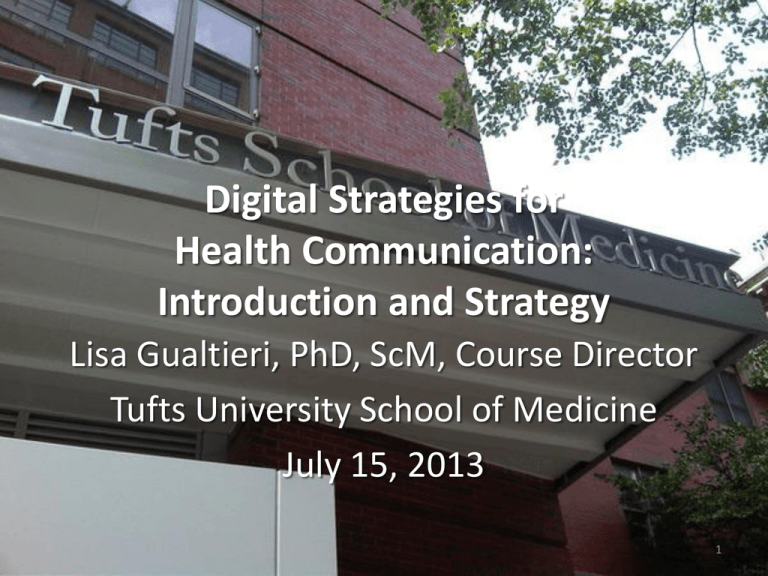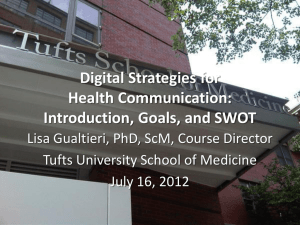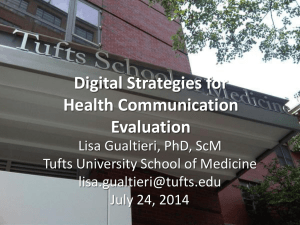Slides - Digital Strategies for Health Communication
advertisement

Digital Strategies for Health Communication: Introduction and Strategy Lisa Gualtieri, PhD, ScM, Course Director Tufts University School of Medicine July 15, 2013 1 Agenda for July 15 9:00 9:01 9:10 9:20 10:15 10:30 12:30 1:00 2:00 3:15 3:30 4:45 Welcome from Lisa Gualtieri, PhD, ScM, Course Director Welcome from Aviva Must, PhD Dean, Public Health and Professional Degree Programs Tufts University School of Medicine Welcome from Sue Gallagher, MPH Program Director, Masters of Science in Health Communication Program Tufts University School of Medicine Introductions Robyn Alie and Frank Fortin, case study presenters, MA Medical Society Lisa Gualtieri, course director Lena Feng, teaching assistant Students Project teams Break in Alumni Lounge Robyn Alie and Frank Fortin, MA Medical Society’s digital strategy Lunch: served in Alumni Lounge Lisa Gualtieri: Overview of digital strategy, goals, & SWOT analysis Teams: SWOT analysis for Mass Medical Society Break: with food and drinks in Alumni Lounge Teams present SWOT analyses Evaluations 2 Why we offer Tufts Summer Institute on Digital Strategies for Health Communication • Most healthcare and public health organizations ask: – Do we need to update our website, which hasn’t been touched in 3 years? – What exactly is Pinterest for and should we use it? – Should we set up a weekly twitter chat? – Do we need an app? – Are we reaching our target audiences as best we can? • We want to promote strategic approaches to health communication 3 Aviva Must, PhD 4 Sue Gallagher, MPH 5 Agenda for July 15 9:00 9:01 9:10 9:20 10:00 10:15 10:30 12:00 12:30 1:00 2:45 3:00 4:45 Welcome from Lisa Gualtieri, PhD, ScM, Course Director Welcome from Aviva Must, PhD Dean, Public Health and Professional Degree Programs Tufts University School of Medicine Welcome from Sue Gallagher, MPH Program Director, Masters of Science in Health Communication Program Tufts University School of Medicine Introductions Robyn Alie and Frank Fortin, case study presenters, MA Medical Society Lisa Gualtieri, course director Lena Feng, teaching assistant Students Project teams Break in Alumni Lounge Robyn Alie and Frank Fortin, MA Medical Society’s digital strategy Lunch: served in Alumni Lounge Lisa Gualtieri: Strategy Teams: SWOT analysis for Mass Medical Society Break: with food and drinks in Alumni Lounge Teams present SWOT analyses Evaluations 6 Agenda for the week • Mix of 1. Guest lectures 2. My lectures 3. Work in teams addressing (2) to develop a new digital strategy for Massachusetts Medical Society 7 Students 1. John Hanawalt 2. Kristie Nagpal 3. Hubert J. Park 4. Jared M. Shinabery 5. M.E. Malone 6. Alison Nogi 7. Roanna Forman 8. Susann Glenn 9. Philip "PJ" Hamel 10. Ross Kopelman 11. Deborah Linder 12. Anna Kern 13. Briana Nestor 14. Sheryl Lynn Carvajal 15. Tina Chang 16. Ken Stopay 17. Christine Norris 18. Leslie Simone Byrd 19. Rajaa Nahra 20. Sarah Soffer Course Director & TA Lisa Gualtieri Lena Feng Guest Speakers Robyn Alie Frank Fortin Joseph Kvedar Bill Tancer Tara Montgomery Dan Childs Pete Forsyth Lane Rasberry Tiffany Lo McGee 8 Teams • • • • • Team 1 Team 2 Team 3 Team 4 Team 5 9 Strategy • • • • What is a strategy? What is strategic thinking? Why are they important? What happens when you don’t have – or use – a strategy? 10 Definitions • Vision: outlines what the organization wants to be ideally and how it wants to be perceived • Mission: defines the organization’s purpose and how it will achieve its vision • Values: beliefs that are shared in the organization • Strategy: a set of goals in support of the vision and mission and in accord with the values, and a plan of action to achieve them • Tactics: means to accomplish strategic objectives • Planning horizon: time frame 11 Strategic thinking • Strategic thinking involves – Long term planning – Determining priorities – Identifying potential risks and opportunities – In support of an organization’s vision and mission 12 Mission statement • The mission of the Massachusetts Society for the Prevention of Cruelty to Animals (MSPCA)–Angell Animal Medical Center is to – protect animals, – relieve their suffering, – advance their health and welfare, – prevent cruelty and – work for a just and compassionate society. 13 Vision statement • The MAC vision is that, by 2012, there will be a sustainable, effective, and widely utilized forum for dialogue and strategic collaboration within the Massachusetts animal welfare community that will reduce the number of homeless, neglected, displaced, and abused animals. 14 MMS mission: June 11, 2013 • Our Mission – The Massachusetts Medical Society was established as a professional association of physicians by the Commonwealth of Massachusetts in an Act of Incorporation, Chapter 15 of the Acts of 1781. Section 2 of that Act states: – "The purposes of the Massachusetts Medical Society shall be to do all things as may be necessary and appropriate to advance medical knowledge, to develop and maintain the highest professional and ethical standards of medical practice and health care, and to promote medical institutions formed on liberal principles for the health, benefit and welfare of the citizens of the Commonwealth." • Our Vision and Strategic Direction – "The Massachusetts Medical Society will continue to be a proactive organization. We will advocate for the shared interests of patients and our profession. We seek to unite all physicians and serve the common interests of the profession. Our goals are to enhance and protect the physician-patient relationship and to preserve the physician's ability to make clinical decisions for the benefit of patients. The Society will continue to encourage the development of standards for high quality care. We will continue to promote our code of ethics to physicians, patients, and the public. We will work collaboratively within the profession and with the public. The Society will address the professional needs of physicians and take a leadership role in the development of health care policy. We will promote medical education, training, research, and the continuing education of physicians. We will communicate clearly and effectively with our members and the public to build awareness of and support for our goals." 15 MMS strategic priorities • Strategic Priorities 2013-2014 – – – – • The MMS strategic priorities for 2013–2014 are the following: improve health care quality, access, and equity for patients, while delivering cost-effective care and promoting a sound public health system for the Commonwealth. In order to advance the mission of the MMS, the goals of our strategic plan will be the following: Physician advocacy, education, and outreach: advance the position of the MMS as a leader and credible physician voice at the state and federal level on payment reform, practice innovation initiatives, professional liability reform, clinical integration options, the impact of variation in care on quality and cost, and access to information technology. Patient care advocacy: expand and promote physician-led efforts regarding accurate data for physicians and the public for quality improvement initiatives, quality and cost performance measurements and measurement methodologies to help ensure that they are scientifically valid, reliable, and meaningful. Physician representation: demonstrate that the Society has a valuable impact on physician practices, regardless of employment structure, by providing practice tools/resources, implementing new modes of education and communication, and increasing the number of physician members in all areas of the state. Strategic Priorities for 2011-2014 – – – – – – The Massachusetts Medical Society's strategic priorities for 2011-2014 are the following: improve health care quality, access, equity, and cost-effectiveness for the Commonwealth and promote a sound public health system. The goals for our strategic plan rooted with the long-term objective of quality improvement and the effective control of health care costs include: Playing a leadership role in developing a sustainable model of health care delivery that will preserve the integrity of the doctor patient relationship and ensure the best care for patients. Advocating for practice viability, including appropriate payment reform efforts, professional liability reform, a sustainable physician workforce and an optimal practice environment. Remaining fully engaged in the health reform debate and communicating issues to the membership. Ensuring that the performance measurements are valid, reliable and data are accurate and shared with physicians in a transparent and meaningful way with the right to appeal. Promote public sharing of clinical and practice data, including evidence-based guidelines and knowledge through effective educational interventions, and collaborative efforts. 16 Digital strategy • Start with vision, mission, and current strategy • Develop new strategy in alignment with vision, mission, and values and modified by constraints • Encompasses use of web, social media, and mobile to reach target audience(s) • Start with goals and SWOT Design Existing digital strategy Goals Personas Content SWOT Competitive analysis Technology Evaluation New digital strategy 17 Digital strategies encompass measurable goals • Generally to be to be better, faster, or more – Acquire new audiences – Retain current audience with new services – Increase loyalty/page views/followers/etc. – Increase word-of-mouth and viral promotions – Improve branding and awareness – Reduce content creation costs – Decrease content creation time – Respond rapidly and effectively to crises – Increase overall health 18 Ask strategic questions to develop goals • • • • • • • Who do we want to reach? Which products and services can we offer? Will they be integrated, and, if so, how? How will content be created or obtained? Should we charge or seek sponsors or ads? Is the commitment short- or long-term? Are we leaders or followers? • Who do you ask? Internal? External? 19 Brainstorm to develop creative and perhaps unusual goals • Henry Ford: “If I had asked people what they wanted, they would have said ‘faster horses.’” • Example from Lowell General Hospital 20 21 Merrimack Valley Moms 22 Modify goals based on constraints • Internal: organization – – – – – Alignment with vision, mission, and values Leadership Budget Technological knowledge Fears • External: target audiences – Technological knowledge and platforms – Health literacy skills – Health conditions • External: competition 23 Evaluate and prioritize goals • • • • • Are goals realistic and achievable? How will we measure success? What else do we need to know? Who needs to approve? Prioritize goals based on potential impact and ease of implementing 24 Summary: Goals • • • • • • Start with vision, mission, and values Ask strategic questions Brainstorm and be creative Modify based on constraints Evaluate and prioritize goals Develop measures of success 25 SWOT Strengths • 1. • 2. • 3. • 4. • 5. • 6. Weaknesses • 1. • 2. • 3. • 4. • 5. • 6. Opportunities • 1. • 2. • 3. • 4. • 5. • 6. Threats • 1. • 2. • 3. • 4. • 5. • 6. A digital strategy needs to maximize the potential of the strengths and opportunities while minimizing the impact of the weaknesses and threats 26 Course project • Course project is developing a new digital strategy for MMS in teams • Robyn and Frank presented current strategy • Teams will develop goals and SWOT analysis – Use worksheet – Present by developing a few PowerPoint slides for presentation 27 Teams • • • • • Team 1 Team 2 Team 3 Team 4 Team 5 28








